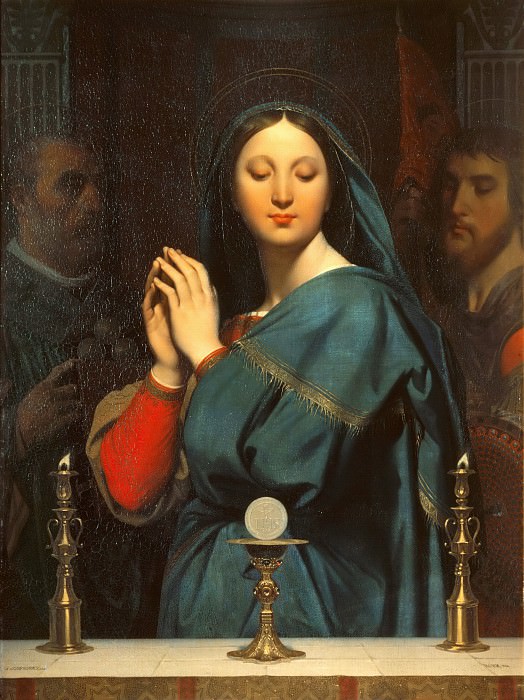Virgin Adoring the Host Jean Auguste Dominique Ingres (1780-1867)
Jean Auguste Dominique Ingres – Virgin Adoring the Host
Edit attribution
Download full size: 2788×3726 px (1,9 Mb)
Painter: Jean Auguste Dominique Ingres
Location: Pushkin State Museum, Moscow (ГМИИ им. Пушкина).
Jean Auguste Dominique Ingres was the main face of nineteenth-century academism. Known both as an artist and as a musician - as a young man he played in an opera orchestra. Almost half of his adult life he spent in Italy. His oeuvre can be divided into several stages. He was formed early as an artist, and was strongly influenced by the art of the Middle Ages. During the first Italian period (1806-1824) he painted pictures very close to Romanticism.
Description of the painting "Madonna Before the Communion Bowl" by Jean Auguste Ingres
Jean Auguste Dominique Ingres was the main face of nineteenth-century academism. Known both as an artist and as a musician - as a young man he played in an opera orchestra. Almost half of his adult life he spent in Italy. His oeuvre can be divided into several stages. He was formed early as an artist, and was strongly influenced by the art of the Middle Ages. During the first Italian period (1806-1824) he painted pictures very close to Romanticism. In Paris in his twenties he became interested in neoclassicism, but constantly went beyond this genre, due to which he had to break with the Paris Salon. Engr believed that after Raphael the development of art had gone in the wrong direction, and that his task was to continue painting from the level of the Renaissance, blotting out all subsequent artistic achievements.
The painting Madonna Before the Communion Bowl was painted during the artist’s second stay in Rome. At that time he was living in the Villa Medici - just as he had a quarter of a century earlier. The reason for the move to Italy was an official appointment - Engrère became director of the French Academy in Rome. During this period, he carried out a reform of the education of artists, considering the main thing for the young masters of education on the artistic masterpieces of the past. Paintings of the second Roman period to our time survived a little. The painting "Madonna before the Cup of Communion" was ordered by the heir to the Russian throne, the future Emperor Alexander II. The heir wished that to the left and to the right of the Madonna were portrayed two saints revered in Russia - Nicholas the Wonderworker and Alexander Nevsky.
In the center of the painting we see the Madonna, brightly illuminated in gold. The source of light is outside the picture, the light comes as if from the viewer. The woman’s eyes are modestly downcast, but the coquettish half-smile on her face forms a contrast to the classical religious subject. The canvas is saturated to the limit with symbols. The number of objects on the table is equal to the number of characters - in fact, the objects represent the characters. The candlesticks are symbols of masculinity, while the feminine essence is represented by the rounded wax. In Russia the painting was not fully appreciated; numerous critics complained that it was essentially Catholic and had nothing to do with Orthodoxy.
Кому понравилось
Пожалуйста, подождите
На эту операцию может потребоваться несколько секунд.
Информация появится в новом окне,
если открытие новых окон не запрещено в настройках вашего браузера.
You need to login
Для работы с коллекциями – пожалуйста, войдите в аккаунт (open in new window).















You cannot comment Why?
In front of her, on an altar-like surface, rests a golden chalice holding a white host, a symbol of the Eucharist. Two ornate brass candlesticks, one on each side, hold lit flames, their soft glow illuminating the scene. The background is dark and indistinct, but figures of men can be seen on either side of Mary, their faces shadowed and somewhat obscured, suggesting they are witnesses or perhaps guardians. One figure on the left appears to be an older man in clerical attire, while the figure on the right, dressed in armor or warrior garb, could represent Joseph or a soldier.
The subtext of the painting lies in its portrayal of Marian devotion and the significance of the Eucharist. Marys rapturous posture and elevated halo emphasize her sanctity and her unique relationship with the divine. The presence of the host signifies a moment of spiritual communion and adoration, placing the sacrament at the heart of the scene. The surrounding figures, though less prominent, serve to contextualize Marys role within the Christian narrative, possibly representing earthly authority or protective presence. The overall atmosphere is one of solemn reverence and deep faith.